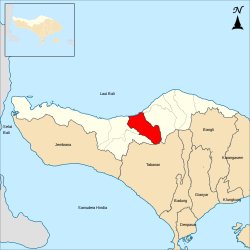

Banjar is a district ( kecamatan ) in the regency of Buleleng in northern Bali, Indonesia. [1]
A notable waterfall, Singsing Waterfall, is located in the district, [2] Tigawasa, in the village of Temukus, around 3 km south-east of Lovina Beach and 10 km south-west of Singaraja town.
In the village of Banjar Tegeha near the town of Banjar, is the Brahma Arama Vihara Temple, [3] [4] also known as the Banjar Buddhist Temple, largest buddhist temple in Bali. [5]
Another buddhist site in the district is the "Candi Buddha Kalibukbuk", in the village of Kaliasem (just west of Kalibukbuk). [6] [7]